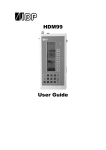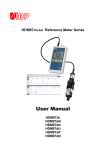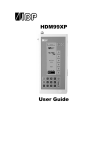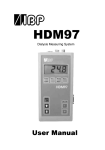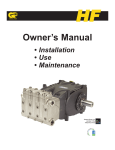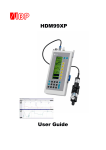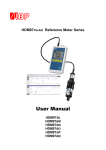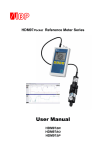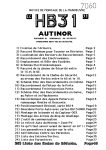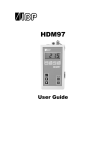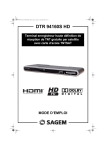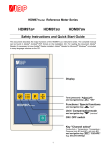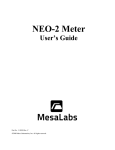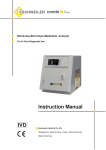Download User Manual
Transcript
HDM99 Dialysis Measuring System User Manual The information contained in this documentation can undergo changes without special announcement. IBP Instruments GmbH takes no responsibility with this document. The contained software is being delivered on the basis of a general licence contract or in single license. Use or reproduction of the software is allowed only in agreement with the contractual arrangements. Whoever transfers this software and/or this manual on magnetic tape, diskette or any other media, except for the purpose of own use, without written authorization of the IBP Instruments GmbH, is liable to prosecution. Copyright (C) 1996-2000, IBP Instruments GmbH. All rights reserved Publisher: IBP Instruments GmbH Sutelstr. 7A D 30659 Hannover Manual author: Werner Pfingstmann 3rd Edition August 2000 IBP Instruments Inc 635 South Orange Avenue. Sarasota, FL 34236 Attention Read these safety instructions before using the HDM99 • Please read the manual before using the HDM99. • Keep away the device from unauthorized persons. • Never use the HDM99 with connected battery charger on a dialysis machine to which a patient is connected. • Operate the instrument only in a dry environment, and do not touch it with damp hands. Ensure that no fluids intrude into the interior of the device or into the sockets at the front. • Apply a protection filter to the nozzle for the pressure measurement . • Avoid a discharge of static electricity over the sockets. It could lead to the destruction of your measuring device. Before touching the sockets and lines that are connected with them, keep an eye on the discharging of static electricity. • Voltages above 40V can be dangerous. Take extreme care while working with higher voltages. • To avoid electrical shocks, and/or damage to your measuring system, do not apply excess voltages above 40 V to the instrument. • Only calibrate the device if you have understood the consequences to their full extent. • Do not open the device. DELIVERY EXTENT....................................................................................... 6 EC-CONFORMITY DECLARATION............................................................. 7 GUARANTEE DIRECTIVES........................................................................... 8 INTRODUCTION ............................................................................................. 9 CONNECTIONS ................................................................................................ 10 CHARGE CONNECTION .................................................................................... 11 TURNING ON THE DEVICE ................................................................................ 13 MAIN MENU ................................................................................................... 13 MEASUREMENT .............................................................................................. 15 TEMPERATURE MEASUREMENT............................................................. 17 CONDUCTIVITY MEASUREMENT ............................................................ 18 CONDUCTIVITY AND TEMPERATURE MEASUREMENT.................... 21 FURTHER POSSIBLE MEASUREMENTS .................................................. 25 PH MEASUREMENT..................................................................................... 26 PH-CALIBRATION IN THE MEASURING MODE .................................................... 30 FLOW MEASURING ..................................................................................... 31 MANAGEMENT OF DIFFERENT SENSORS ........................................................... 31 COUNTER ....................................................................................................... 34 POOL MENU .................................................................................................. 35 VOLTAGE MEASUREMENT - PLOTTER .................................................. 36 VOLTAGE MEASUREMENT - OSCILLOSCOPE ...................................... 38 BATTERY VOLTAGE ................................................................................... 40 INSTALLATION............................................................................................. 41 LANGUAGE .................................................................................................... 41 SWITCH-OFF TIME ........................................................................................... 41 ADJUST-RESET ............................................................................................... 42 CALIBRATION OF THE HDM99 ................................................................. 43 ADJUSTMENT ................................................................................................. 43 CALIBRATION OF TEMPERATURE MEASUREMENT ............................................. 45 CALIBRATION OF CONDUCTIVITY MEASUREMENT ............................................. 47 CALIBRATION OF THE PRESSURE MEASUREMENT .............................................. 51 CALIBRATION OF PH-MEASUREMENT............................................................... 53 PH-CALIBRATION........................................................................................ 54 CALIBRATION OF FLOW............................................................................ 55 CALIBRATION OF THE VOLTAGE MEASUREMENT ............................ 57 MAINTENANCE AND CARE OF THE HDM99........................................... 58 STORAGE ........................................................................................................ 58 CLEANING ...................................................................................................... 59 CALIBRATION INTERVALS ............................................................................... 60 SPECIFICATIONS FOR THE HDM99.......................................................... 62 RS-232-INTERFACE ...................................................................................... 64 HDMCMO STARTS BACKGROUND MEASUREMENT........................ 66 12964.12/ 24.7/ 750/ 7.00/ -0.03/ 0.05/6.12/1200/1000/79131/999999 + CR LF à 73 SIGNS......................................................................................................... 66 6 Delivery extent The hardware of HDM99 consists of: HDM99 Combined electrode conductivity / temperature Flow-through connector for conductivity/temperature probe Pressure measuring tube Voltage measuring cables Count input measuring cables Battery charger Standard solution conductivity 13,63 mS/cm The documentation of HDM99 consists of this manual. If you should miss anything, please contact your supplier. Introduction Introduction 7 EC-Conformity Declaration Hereby we declare that the HDM99 corresponds to the basic requirements for protection according to the guidelines of the board for the assimilation of legal regulations about electro-magnetic compatibility (89/336/EWG) of the member states. For the rating of the devices in view to their electro-magnetic compatibility the following norms have been used: Emission: Immission: EN 55022 Class B IEC 801-3 Criterion A IEC 801-2 Criterion A IEC 801-4 Criterion B This declaration is responsibly given for IBP Instruments GmbH Sutelstr. 7A 30659 Hannover by Dipl. Ing. Werner Pfingstmann Managing director Hannover, September 30, 1996 8 Introduction Guarantee directives The existing product is a technical device which contains only modern electronic components. During the manufacturing exclusively first choice parts are used. Each device undergoes extensive tests before delivery. IBP warrants that the device is free from defects in material and workmanship for a period of 12 months beginning at the date of delivery. Excluded from the guarantee are damages by improper treatment, inappropriate usage, by connecting to excess voltages, modifications in the device or through risks which the user has to cover by a suitable insurance (fire, water, intrusion, robbery etc.) All conceivable measures were met to assure the accuracy of this productdocumentation. IBP cannot grant any guarantee for the completeness and the accuracy of the software and the documentation. IBP is not responsible for damages (including, but not limited to, damages for loss of business profits, business interruption, loss of data, and other special, incidental or consequential damages) which emerge through the usage of the product by the customer. Introduction 9 Introduction HDM99 is an innovative computer processed measuring system with which nine parameters can be measured: Conductivity Temperature Pressure pH Flow Voltage Frequency Period time Events The device has been developed for the usage on dialysis machines, but is also usable in the labor in the environmental measuring technology. The handling is uncomplicated and follows the motto: Only the manual is necessary in cases of doubt. The entire handling is led by dialogues. The calibration of the device by the user is simple and gives no problems. The display of measurement results is available n numerical and also in graphical form. Via the serial interface the measurements can be called independently of the current display, and further processed or presented on a PC. For the fault location at dialysis machines IBP has developed a program that presents and processes measurements of the HDM99 and of the machine together. Provided that the dialysis machine is equipped with an interface according to RS232- or RS485-standard. Drivers for different instruments are available or in preparation. The program runs under MS-Windows and is therefore easy to operate. 10 Introduction Connections voltage _ conductivity pressure and temperature pH + Voltage The sockets are intended only for AC and DC voltages up to 40 V. They are protected up to 80 V. Conductivity / Temperature The conductivity measurement is designed for quadropole technology. Please use exclusively the electrode delivered with the device by IBP. Pressure To avoid damages at the pressure probe or inaccuracies in measurement, ensure that no fluids intrude into the device. We recommend the application of a protection filter. pH The input bushes are intended exclusively for pH-electrodes. Other signals may destroy the device. Introduction 11 Flow The connection is to be found at the right side of the device. (8pol. connector) Frequency, Periodicity and Events The connection on the right side of the device is also used for the measuring of the flow. The incoming voltage range is +5...+24 V. The form of the signal should be of a rectangular form and has to be positive. Charge connection The charge connection is found at the right side of the device. The connection is provided with 12 V / 500 mA by the included battery charger. For safety reasons never use the HDM99 with connected battery charger on a dialysis machine to which a patient is connected. 12 Introduction Combined electrode in Hansen-connector In the flow-through mode the connector is suitable for measuring pressure, temperature and conductivity. In the dip-in mode temperature and conductivity can be measured. The preferential position of the Hansen-connector is vertical, the axial supply shows downward. In the flow-through mode the axial supply is used as input and the radial supply as output (see illustration). The pressure probe in HDM99 is fastened to the radial connection above the input. Before any measurements you must shake the connector to assure that any air within the system escapes. For the dip-in mode open the screw cap at the upper end of the connector and extract the combined electrode. You must not remove the tube covering the probe carrier. Dip the electrode into the media up to a level above the borings in the covering tube. By moving the electrode you assure that the contained air can escape and the temperature is well balanced. Do not touch the surface of the electrode with your fingers. Introduction 13 Turning on the device The device is switched on and off with the keys ON and OFF. In addition to that, the device automatically switches off when the accumulator is exhausted, or after the elapsing of an adjustable time. Main menu After switching on the device you receive an information menu for approx. two seconds. After that the system goes back to the last setting. In some cases you will receive the following main menu. Activation of the function keys leads to display of the info-menu display of the measuring menu display of the calibration menu display of the installation menu 14 Introduction Info From the root menu via info you receive the following information: There are device specific data like product name, software version and version date as well as the serial number of your HDM99. Measurement Measurement From the main menu over measuring you will receive the following menu: 15 16 Measurement Examples for measurement displays F1 F1 F2 F2 F3 F3 F4 F4 F5 F5 F6 F6 The handling of all menus corresponds to the already explained operating instructions. The individual menus and sub-menus are presented and explained below. Measurement 17 Temperature measurement Time range By activation of the function key param. you will receive a menu which allows to change the time range, in which the course graphic will run through horizontally once. Long term measurements up to twelve hours are possible. Since you do not have all possible times presented simultaneously, a black beam on the right side shows that above, or - like in the example - further options hide themselves below. The selected time range is shown inverted. To change the time range, operate the function keys beside the arrows upward or downward. When you have selected the suitable time range for your application, return to the temperature measurement with the activation of ok. The length of the horizontal axis of the graph now corresponds to the chosen time range. 18 Measurement Conductivity measurement After activation of the function key param. you will get to the menu which allows you to change the time range (horizontal axis of the graph) or the yrange (vertical axis) and also the temperature coefficient. By activation of the function key for the range to be changed you see the selection menus. At the time range long term measurements up to twelve hours are possible. Since you do not have all possible times presented simultaneously, a black beam on the right side shows that above, or - like in the example -, further options hide themselves below. The selected time range is shown inverted. To change the time range, operate the function keys beside the arrows upward or downward. When you have selected the suitable time range for your application, return to the temperature measurement with the Measurement 19 activation of ok. The length of the horizontal axis of the graph now corresponds to the chosen time range. After the choice of the field y-range four fixed measuring ranges can be selected in the already explained way with the function keys beside the arrows. If you choose > auto <, the HDM99 automatically adjusts the measuring range so that an optimal graphic representation of the running measurement is assured. With activation of the function key ok you arrive back in the conductivity measurement. The vertical axis of the course graphic as well as the scale length of the beam display now correspond to the measuring range you have chosen. The temperature coefficient menu point allows many different setting possibilities. In the parameter menu for conductivity and also conductivity + temperature, it is possible to choose from a list of preset temperature coefficients of various dialysis machine manufacturers. These are listed by name. There is also a standard value of 2.07% / °C and a user value. The user value can be changed in the usual way in the adjustment menu for conductivity. All settings are permanent until the next change. The selected setting is shown in the measurement menu. 20 Measurement Basic information about the temperature coefficient The temperature coefficient in conductivity measurement is an important subject that is frequently neglected. The conductivity of a solution changes with the temperature. As the temperature rises, the conductivity of the measurement solution increases also. In order to arrive at meaningful measured values, the display value is compensated to 25°C. Expressed in another way, the display is always converted to a solution temperature of 25°C. The temperature coefficient with which the display is compensated is expressed in % / °C. However, different solutions now unfortunately also have different temperature coefficients. For the display to be precise, the measuring unit must therefore be set to the temperature coefficient of the current solution. The average temperature coefficient for dialysate is 2.07% / °C. A value of 1.97% / °C is frequently used for natural water. To perfect the chaos, the different manufacturers of dialysis machines also use different temperature coefficients in their machines. Baxter Braun FMC Gambro Hospal Nikkiso Bicarbonat Total conductivity 2,20 %/°C 2,00 %/°C 2,10 %/°C 1,80 %/°C 2,07 %/°C 2,02 %/°C 2,05 %/°C This gives rise to the following recommendations: 1. You have machines from one manufacturer only: Use the temperature coefficient that the dialysis machine uses for compensation 2. You have machines from different manufacturers: Use as a temperature coefficient a mean value. 2.07% / °C is recommended for this. Measurement Conductivity and temperature measurement 21 22 Measurement Measuring range conductivity After the choice of the field y-range four fixed measuring ranges can be selected in the already explained way with the function keys beside the arrows. If you choose > auto <, the HDM99 automatically adjusts the measuring range, this way an optimal graphic representation of the running measurement is assured. By activating the function key ok you will get back to the conductivity and temperature measurement. The vertical axis of the course graphic, as well as the scale length of the beam display, now correspond to the measuring range you have chosen. The temperature coefficient menu point allows many different setting possibilities. In the parameter menu for conductivity and also conductivity + temperature, it is possible to choose from a list of preset temperature coefficients of various dialysis machine manufacturers. These are listed by name.There is also a standard value of 2.07% / °C and a user value. The user value can be changed in the usual way in the adjustment menu for conductivity. All settings are permanent until the next change. The selected setting is shown in the measurement menu. Measurement 23 Pressure measurement Time range After activation of the function key time range you will get to a menu which allows to change the time range (horizontal axis of the graph). Long term measurements up to twelve hours are possible. Since you do not have all possible times presented simultaneously, a black beam on the right side shows that above, or - like in the example -, further options hide themselves below. The selected time range is shown inverted. To change the time range, operate the function keys beside the arrows upward or downward. When you have selected the suitable time range for your application, return to the temperature measurement with the activation of ok. The length of the horizontal axis of the graph now corresponds to the chosen time range. 24 Measurement Unit The unit for the pressure measurement can be chosen. The values are converted when the unit is changed. A new calibration is not necessary. The selection of the unit is done in the familiar way with the function keys beside the arrows. With ok you return to the pressure measurement, where now the results will be shown in the newly chosen unit. Taring Caused by drift of the pressure probe, the pressure display may sway slightly around zero. With the function tare the display is set to zero. You must not apply pressure to the HDM99 during this function. This is assured when the pressure tube is not connected. Then the environmental pressure represents zero. The choice of the function key tare results in the reset of the display to zero and the automatic return to the pressure measurement. Measurement 25 Further possible measurements With the option other channels you can shift to a second measuring menu where you have the choice between two different modes of voltage measurement: the test for pH-value and the control of the charging state of the accumulators. If you would like to return to the first measuring menu with conductivity, temperature and pressure measurement choose other channels again. 26 pH Measurement Measurement Measurement 27 Time range By activation of the function key param. you will receive a menu which allows to change the time range in which the course graphic will run through horizontally once. Long term measurements up to twelve hours are possible. Since you do not have all possible times presented simultaneously, a black beam on the right side shows that above, or -like in the example- further options hide themselves below. The selected time range is shown inverted. To change the time range, operate the function keys beside the arrows upward or downward. When you have selected the suitable time range for your application, return to the temperature measurement with the activation of ok. The length of the horizontal axis of the graph now corresponds to the chosen time range. 28 Measurement Temperature compensation pH-measurement For the temperature calibration of the pH-measurement the device offers two possibilities. The solution temperature can be measured via the conductivity and temperature electrode, or entered by hand. The chosen kind of the calibration is check-marked in the menu point measure t-comp or enter t-comp. If you choose measure t-comp. no further input is necessary. The temperature will be measured via the measuring cell. By choice of enter t-comp. you will be asked to enter the solution temperature via the numeric keyboard. After confirmation with >ENTER< you will return to the menu for the parameter setting Fundamental information about pH-measurement For the measurement of the pH-value a combined electrode is used. pH electrodes are combinations of one reference electrode and one measuring electrode in a glass tube. The pH-value in the dialysate is measured by an unbreakable pH-electrode. The glass body is protected with a plastic coat and due to the jellyelectrolyte-filling maintenance-free. This electrode` s diaphragm must be stored in 3 mol/l KCl-solution. The protection hood must be refilled every three to four weeks. Measurement 29 For pH-measurement in untreated desalinated water a particular electrode is necessary. This glass electrode is optionally available and has a 1 mol/l KCl reference electrolyte. The diaphragm of this electrode must be stored in 1 mol/l KCl-solution. Before usage the electrode must be checked on exterior damage and glass crash. Crusts caused by leaking electrolyte can be removed easily by rinsing. The sample volume should be 100 ml dialysate or 1 l of untreated water. The sample volume is being led to the bottom of the vessel with a tube or hose for coming as little as possible into contact with air. The pHvalue must be measured immediately in the same vessel. You have to make sure that the display stabilizes before the value is read. In stirred solutions the response rate is faster, the value, however, must be measured at resting fluid. The pH-electrode must be dabbed only and never rubbed dry. The rubbing destroys the jelly layer on the glass surface which results in a longer response time of the electrode. Due to the special electrode, for pH-measurement in untreated water further points need to be paid attention to: air bubbles in the membrane space of the electrode can be removed easily by shaking movements similar to a clinical thermometer. The reference electrolyte in this electrode can be refilled. Make sure that the refill cap is sealed with the rubber hood. The level of the reference electrolyte must always be sufficiently large. Before the measurement the rubber hood must be removed, since otherwise no internal pressure compensation occurs. On the lower shaft of the electrode a plastic part is to be found which must always remain freely movable on the shaft. If the mobility of the plastic part should be restricted it can be released by rinsing with lukewarm water. This plastic part conceals an opening in the glass which must be covered always. Pressure and currents have considerable influence on the pHmeasurements. Therefore, it is necessary to accomplish the pHmeasurement in a resting solution at environmental pressure. 30 Measurement pH-calibration in the measuring mode Calibration Before the adjustment the kind of temperature calibration must be set already. Prepare two buffer solutions. The two buffers should not differ more than two activation decades. Choose, for example, pH4 and pH6. Carefully remove the protection hood for the measurement. Rinse and dab the pH electrode with distilled water before dipping it into the buffer. If necessary wash and dry the temperature sensor likewise, and put it into the measuring beaker. Wait until the display remains stable, then enter the pH-value via the numeric keyboard. Confirm your input with > ENTER <. Then wash and dry the electrode and dip it into the second buffer. When the value of the second buffer is entered, the display shows the actual calibration. If thereby the graduation (grad) is lower than 85%, the electrode could be worn out and must be replaced by a new one. If you try to enter two equal values the reference invalid data appears after confirming with ok; at correct input the data will be saved, and you will return to the menu for the parameter setting. Measurement 31 Flow measuring The current flow rate and the amount of flown liquid will be shown. The amount of flown liquid can be restored to zero by pushing Reset. Management of different sensors For the measuring of the flow different sensors will be used according to the measuring unit. The HDM99 governs up to 15 different sensors. For detecting the different sensors a code is put on them. This code is used for the internal choice of calibration data. The number of the connected sensors will be shown in the display. Any sensor can be used which has an output signal that delivers a frequency proportional to the flow running. The amplitude at the entrance of the HDM99 may have a range of 5...24 V. For the current supply of the sensors 5 V DC/ 10 mA are available at the connection of the flow measuring. 32 Measurement Connection occupancy of the plug connection for the flow measurement Pin 1 2 3 4 5 6 7 8 Meaning currency supply sensor 5 V/ max 10 mA signal input 5...24 V max 1 MHz GND code input 0 code input 1 code input 2 code input 3 shield for supply 33 Measurement Codes for the different sensors Sensor 1 2 3 4 5 6 7 8 9 10 11 12 13 14 15 Pin 4 GND 5V GND 5V GND 5V GND 5V GND 5V GND 5V GND 5V GND Pin 5 GND GND 5V 5V GND GND 5V 5V GND GND 5V 5V GND GND 5V Pin 6 GND GND GND GND 5V 5V 5V 5V GND GND GND GND 5V 5V 5V Pin 7 GND GND GND GND GND GND GND GND 5V 5V 5V 5V 5V 5V 5V Remark IBP Sensor 1 IBP Sensor 2 IBP Sensor 3 IBP Sensor 4 IBP Sensor 5 IBP Sensor 6 IBP Sensor 7 IBP Sensor 8 If you use your own sensors, please choose a code beginning at number 9. The numbers 1...7 are reserved for the IBP sensors. 34 Measurement Counter By operating one of the three functions you get optionally to the measuring menu for frequency, period duration , or event measuring. All measurements can be done up to a frequency of 1 MHz. In the event measuring, the counted events can be reset to zero by operating reset. Measurement 35 Pool menu Pool is a menu in which the following channels are displayed simultaneously: Conductivity, temperature, pressure, flow. All necessary settings, e.g. the temperature coefficient for the conductivity measurement or the unit for the pressure measurement, are taken from the corresponding measurement menus and can also only be changed there. 36 Measurement Voltage measurement - plotter Time range By activation of the function key param. you will receive a menu which allows to change the time range in which the graph will run through horizontally once. Long term measurements up to twelve hours are possible. Since you do not have all possible times presented simultaneously, a black beam on the right side shows that above, or - like in the example - further options hide themselves below. The selected time range is shown inverted. To change the time range, operate the function keys beside the arrows upward or downward. When you have selected the suitable time range for your application, return to the Measurement 37 temperature measurement with the activation of ok. The length of the horizontal axis of the graph now corresponds to the chosen time range. Damping By operating the function key damping you will get a time table with a choice of periods between zero and ten seconds. Those can be chosen in the usual way with the function keys beside the arrows upward or downward. By use of the chosen period of time a gliding average value of the measured voltage will be calculated and put on display. Please note that voltage sways which are shorter than the selected damping period can not be recorded. Voltage display In the beam display the momentary value of the voltage is displayed. The voltage measurement in the plotter mode is particularly feasible for the measurement of voltages which are subject to no fast sway, therefore DC voltages and low frequency AC voltages. Filter By choice of the function key filter you will receive a time table with periods between zero and 10 seconds to select. Those can be operated in the familiar way with the function keys beside the arrows. An average value of the measured voltage over the selected period is calculated and reported. Please note that voltage sway which is shorter than the selected filter period can not be recorded. 38 Measurement Voltage measurement - oscilloscope Time range By activation of the function key param. you will receive a menu which allows you to change the time range in which the graph will run through horizontally once. Long term measurements up to twelve hours are possible. Since you do not have all possible times presented simultaneously, a black beam on the right side shows that above, or - like in the example - further options hide themselves below. The selected time range is shown inverted. To change the time range, operate the function keys beside the arrows upward or downward. When you have selected the suitable time range for your application, return to the temperature measurement with the activation of ok. The length of the horizontal axis of the graph now corresponds to the chosen time range. Measurement 39 Voltage Display In the beam display the R.M.S. value of the voltage is shown. The voltage measurement in the oscilloscope mode serves mainly for the measurement of voltages subject to higher frequency, therefore also AC voltages. Measuring range By activating the function key y-range it is possible to select a measuring range for the vertical axis of the graph via the arrow-keys which allows a maximum resolution of the voltage graph. The chosen measuring range is shown inverted. With the ok-key you transfer it to the voltage measurement. Trigger With this function key you will get to a menu where you can adjust the mode of the measurement triggering. Press the keys beside the arrows until the desired triggering is presented inverted. In detail the options mean: No trig. The applied voltage is shown without triggering. + AC The rising edge of the average value of the applied voltage is triggered. - AC The falling edge of the average value of the applied voltage is triggered. +DC The rising edge at the zero passage of the voltage is triggered. -DC The falling edge at the zero passage of the voltage is triggered. Take over the chosen triggering with the ok-key, and return to the voltage measurement. Please note that a successful triggering can only take place if a suitable voltage signal is applied. Otherwise >no trigger< appears in the graphic display. 40 Measurement Battery voltage To avoid fail functions never use the HDM99 without batteries. Charging state of the battery If you select the function battery you will receive an information display about the battery voltage and the charging time. The charging state of the installed accumulators can be estimated by the battery voltage. Above, you see from left to right the displays for empty, half and full. The computer processed charging starts with the connection of the charging device. There are two modes of charging, quick-charge and trickle. The light-emitting diodes beside the charging socket indicate these modes. Green stands for trickle, and the red LED indicates quick-charge. In all working modes the empty battery is indicated as >Low-Bat< in the uppermost menu field. With activation of the key measuring you will return to the measuring menu. For safety reasons never use the HDM99 with connected battery charger on a dialysis machine to which a patient is connected. Installation 41 Installation Language By pressing the function key beside the menu point language you will reach the language choice. With the keys beside the arrows you can select the desired language for your work with HDM99. The selection is shown inverted. With activation of ok you will return to the installation menu. After altering the language the entire menu leadership and display appears in the chosen language. Switch-off time The switch-off time is the time after the last key activation. At the end of this time the device switches off automatically. The activation of the function switch-off leads to a selection of times which can be selected with the arrow-keys. The chosen time is shown inverted and taken over with ok as new switch-off time in the installation menu. If >--< is chosen, the automatic power shutoff is cleared, the device remains active until it is switched off manually with the key >OFF<. 42 Installation Adjust-reset With the adjust-reset the calibration values for all measuring channels can be set to basic values. These basic values are the calibration values of the company conducted calibration. Operate the function key beside this menu point. You will have to enter a code via the numeric keyboard. This code is 1704. When you confirm your input with >enter< you will receive the following images: With the function keys beside the individual measuring channels you can decide on which calibration values this function should be applied. The calibration values will be reset to basic values. After that, a new calibration of the reset measuring sizes is necessary. The reset of the flow measurement only resets the parameters of the flow sensors 1....7. The possibly existing calibration values of own sensors remain unchanged. Calibration 43 Calibration of the HDM99 Adjustment The entire calibration of the device is software controlled. Operate the function key adjust in the main menu to reach this function. You will be asked to enter a code via the numeric keyboard. This code is also 1704, and must be confirmed with >ENTER<. After that, you are in the adjust menu. The adjustment of the individual channels is slightly different. The pH- and voltage measurement is adjusted at two points. The temperature and pressure measurement is adjusted at minimally two points, alternatively up to six points. The advantage of more than two calibration points is the higher precision of the measurement as the non-linearity of the sensors will be equalized . The sequence of the calibration in reference to the level of the values is insignificant. Please note, that each value may be entered only once, since the system does not accept the data otherwise. The display will show invalid data. The conductivity calibration results from measuring the cell parameter. Only one calibration point is necessary here. 44 Calibration The calibration of the flow measurement results from measuring of the impulses per liter. Up to 15 different sensors can be calibrated. Only one calibration point is necessary for this. Should you be uncertain if you have entered all values correctly at any point in the run of the calibration of the device, choose the function >cancel<. Then no calibration will be accomplished, and you can start again. Should a calibration prove to be incorrect you can reset this calibration by the function calibration reset within the installation menu. Calibration 45 Calibration of temperature measurement We recommend an examination of the calibration once a year. The calibration is to be accomplished as follows: Operate the function key temp. and follow the instructions on the display. The temperature sensor is dipped into a fluid with known temperature, this temperature is then entered to the HDM99 via the numeric keyboard and confirmed with >ENTER<. The calibration points should be at the following points: 20 °C, 30 °C, 36 °C, 38 °C, 45 °C and 80 °C. After you have entered the last value press the function key stop input. If a higher precision is required at temperatures around 80 °C you can enter further calibration points at 60 °C and 85 °C. In this case choose another input. The calibration value must be entered only if the displayed values are stable. 46 Calibration Calibration 47 Calibration of conductivity measurement We recommend an examination of the calibration once a month. Reference temperature The usual reference temperature is 25 °C. For special applications other values can be used. Use this function only if you are aware of the consequences. By using wrong values you will get a wrong conductivity value. You reach this function by calling the menu point ref.-temp. There you can enter the new reference temperature via the numeric keyboard and confirm it with >ENTER<. By activation of the ok-key the new reference temperature will be saved in the software. 48 Calibration Temperature coefficient For dialysate, the temperature-coefficient of the solution to be measured is 2.070%. For special applications this factor can be changed. Use this function only if you are aware of the consequences. By using wrong values you will get wrong conductivity values. You reach this function by calling the menu point temp.-coeff. You can enter the new temperature coefficient via the numeric keyboard and confirm it with >ENTER<. Pressing the OK button transfers the new temperature coefficient to the program, but it is not used until it is selected in the parameters menu for Conductivity and Conductivity + Temperature. By operating the menu point conductivity range you can choose the correct range with the arrow-keys. While calibrating the solution should have a temperature of approximately 25 °C. As soon as the measuring value in the display is stable the calibration value of the solution can be entered by the numeric keys and can be confirmed with >ENTER<. After the calibration, all values relevant for the conductivity measuring will be indicated once more. By operating the ok-key all data will be saved. While calibrating the conductivity use only fresh standard solutions. Never refill used solutions into the storage bottle! Keep the solutions in a cool place. Calibration 49 Measuring of the cell parameter Before this function can be used, the reference temperature must be adjusted. It is sufficient for the conductivity calibration to know the cell parameter. If this is not known, or has been changed after longer use by deposits on the electrode, this function can be used to define the cell parameter newly. Call the function measure cellpar.in the adjust-menu. In this function the measuring range will not be adjusted automatically. The adjustment for dialysate should be in the area of 13...14 mS/cm. Therefore the measuring range must be 0...20 mS/cm. If the measuring range is too small, the device indicates the overflow with >OFL< above the beam display. Via the menu point measure conduct you can choose the correct measuring range with the arrow-keys. During the calibration the standard solution should have a temperature of approx. 25 °C. When the measurement value in the display is stable, the conductivity value of the standard solution can be entered via the numeric keyboard and confirmed with >ENTER<. After the calibration, all values relevant for the conductivity measurement are indicated once more. With the ok-key the data will be saved. For calibration of the conductivity use only fresh standard solutions. Used solutions should not be refilled into the storage bottle! Keep the standard solutions in a cool place. 50 Calibration Enter cell parameter It is sufficient to enter the cell parameter of the electrode if it is known. This is profitable for an exchange of the electrode. Choose the function input cellpar. Enter the cell parameter via the numeric keyboard and confirm it with >ENTER<. Subsequently, all values relevant for the conductivity measurement will be indicated once more. With the ok-key the data will be saved. Calibration 51 Calibration of the pressure measurement We recommend an examination of the calibration once a year. Operate the function key pressure in the adjust-menu. The calibration of the pressure measurement works like described for the temperature calibration at up to six points. After the input of two points you have the choice whether to terminate the calibration (function stop input), or to enter further values (function another input). The pressure probe is applied with known pressure, and then the values will be entered successively via the numeric keyboard and confirmed with >ENTER<. The calibration points for the measurement on dialysis machines should be at -400, -100, 0, +100 and +500 mmHg. If you call the function stop input after your input, the entered values will be indicated once more, and can be taken over with the ok-key. 52 Calibration The calibration values must be entered only if the values on the display are stable. The sequence of the calibration in reference to the level of the values is insignificant. Please note that each value may be entered only once since the system does not accept the data otherwise. 53 Calibration Calibration of pH-measurement Please read the section Fundamental information about pH- measurement. Temperature calibration of the pH-measurement For the temperature calibration of the pH-measurement the device offers two possibilities. The solution temperature can be measured via the conductivity and temperature-electrode, or entered by hand. The chosen type of the calibration is check-marked in the menu point measure t-comp or enter t-comp. If you select measure t-comp. no further input is necessary. The temperature will be measured via the measuring cell, and you will get to the pH-measurement automatically. By choice of enter t-comp. you will be asked to enter the solution temperature via the numeric keyboard. After confirmation with >ENTER< you will return to the menu for the parameter setting By choice of the function calibration you will reach the pH-calibration directly. The device uses 25°C as default. 54 Calibration pH-calibration We recommend an examination of the calibration before each measurement. Before calibration the type of temperature calibration must be selected already. Prepare two buffer solutions. The two buffers should not differ more than two activation decades. Choose, for example, pH4 and pH6. For the measurement remove the protection hood carefully. Rinse and dab the pH electrode with distilled water before dipping it into the buffer. If necessary wash and dry the temperature sensor likewise, and put it into the measuring beaker. Wait until the display shows a stable value, and then enter the pH-value via the numeric keyboard. Confirm your input with > ENTER <. Then wash and dry the electrode, and dip it into the second buffer. When the value of the second buffer is entered, the display shows the actual calibration. If thereby the graduation (grad) is lower than 85%, the electrode could be worn out and must be replaced by a new one. If you try to enter two equal values, the reference data invalid appears after confirming with ok. At correct input the data will be saved, and you will return to the menu for the adjustment. Calibration 55 Calibration of flow You will get to this function by operating the menu point flow. Up to 15 different sensors will be governed automatically. For calibration the correct sensor must be applied. In case that no sensor should be connected, a fault notice will occur. The running number of the recognized sensor will appear in the following presentations in the upper display. (Look also in the manual under flow measurement) 56 Calibration There are three different ways to calibrate a flow sensor. • Given amount of flow in ml/min or l/min • Given number of impulses per liter • Given amount of the quantity that has flown through Generally the sensor should be calibrated in the middle of the used measuring range. Example: The sensor has a measuring range of 100... 2000 ml/min. Operation range 100...600 ml/min. Then the calibration should be done around 350 ml/min. Given amount of the quantity that has flown through This way of calibration should only be used if no other possibility is available. Ensure the constant flow through the sensor. Then enter the amount of the quantity that has flown through with the chosen unit, and confirm with Enter. Check the calibration once again. This way the calibration is complete. Given number of impulses per liter This type of calibration should be used if the value is known. Enter the value for the number of impulses/liter and confirm with Enter. This way the calibration is complete. Given amount of the flown quantity This type of calibration is the safest way to get to an exact result. Here the amount that has flown through the sensor within 5...10 min will be measured, and this value will then be entered. The HDM99 uses the value to calculate the impulses/liter. If you change to the menu point enter impulse after this calibration, you will get the new calibration value there. Check the calibration once again. This way the calibration is complete. Calibration 57 Calibration of the voltage measurement We recommend an examination of the calibration once a year. You can reach this function by calling the menu point voltage. For the calibration of the voltage measurement you need two values. The calibration values should be at 0 and approx. 40 V=. The sequence of the calibration in reference to the size of the values is insignificant. For the calibration value 0 V create a short circuit between the sockets. For other calibration values apply known voltages to the sockets. The entering of the calibration values is carried out via the numeric keyboard. Please, pay attention that the values in the display are stable, then enter the calibration values, and confirm them with >ENTER<. After input of two calibration values the old and new values will be indicated once more, and can then be taken over with the ok-key. 58 Maintenance Maintenance and care of the HDM99 Generally the HDM99 can be considered as an easy-care instrument. Like at all measuring instruments there is a minimum of maintenance and care necessary to ensure that all functions work flawlessly. For safety reasons never use the HDM99 with connected battery charger on a dialysis machine to which a patient is connected. Operate the instrument only in a dry environment, and do not touch it with damp hands. Ensure that no fluids intrude into the interior of the device, or into the sockets at the front. If this ever happens, open the device and remove the batteries. Sink the whole device into a vessel with distilled water over night. Afterwards, dry the HDM99, and send it to the producer for repair. There are no parts in the HDM99 which you can repair yourself. Please, turn to our technical support at evident malfunctions that can not be removed by a new calibration of the device,. If the device should show any damages, or malfunctions by moisture influence, send it to the producer for repair. Storage Keep the device at a dry place. Suitable is, for example, the original packaging in which you have received the HDM99, or the carrying case offered by IBP as accessory. If you do not use the device over a longer period of time, you should connect it to the included charging device about every two weeks for one hour to avoid exhaustion of the installed batteries. Maintenance 59 Cleaning Never clean the device with any fluids! In case of pollution you can wipe the surface of the HDM99 with a dry and clean cloth. For measurements in the lower conductivity range the cleaning of the conductivity / temperature measuring cell is recommended. Remove watersoluble substances by rinsing with de-ionized water, fats and oils with warm water and household dish washing detergent. Lime and hydroxid crusts can be solved by 10 per cent acetic acid. In each case, the measuring cell needs to be washed with de-ionized water after the cleaning. Basically, the conductivity measuring cell does not decay. Particular measuring media (for example, strong acids and caustic solutions, organic solvents), or too high temperatures shorten the service life considerably, and/or lead to damages. 60 Maintenance Calibration intervals In the delivery state each device is newly adjusted. To assure a reliable function of the HDM99, the different measuring channels have to be calibrated at fixed intervals to examine their precision. This can be done by measuring known sizes, for instance, standard solutions, or proof voltages. If the measured values should deviate from the below indicated permissible limits, a new calibration of the instrument is necessary. We recommend the following intervals for the examination: voltage measurement: pressure measurement: conductivity measurement: temperature measurement: pressure measurement: pH measurement: once a year, once a year, once a month, once a year, once a year, before each measurement. If for individual measuring channels the function adjust reset was used, then a new calibration is necessary for these channels. To handle the calibration, please read the individual sections in which the calibration is described for the different channels. Write down your calibration values and keep them until the next calibration. In case of damage, a calibration protocol can be important for the fault location. If the calibration has been done by the IBP, a sticker will be put on showing the date of the next calibration necessary. For liability reasons you should not carry out the calibration yourself. If IBP has been charged with the calibration, you will receive a calibration certificate which documents the calibration results. 61 Maintenance Allowed limits measuring channel measuring range allowed limits voltage DC 40 V ± 0,05 V voltage AC 40 V ± 0,05 V pressure -700...+1600 mmHg ± 2 mmHg conductivity 0...20 mS/cm ± 0,1 mS/cm temperature 30...40 °C ± 0,1 °C 0...30 and 40...100 °C ± 0,2 °C flow 100...600 ml/min ± 3 ml/min pH pH 0 ... pH 14 ± 0,1 pH 62 Maintenance Specifications for the HDM99 Conductivity 0...20 mS/cm in 4 ranges, quadro-pole-electrode, temperature compensation 20...40°C with 2,07 % per °C (adjustable), temperature sensor integrated in the measuring cell, reference temperature 25°C (adjustable), precision better than 0,25 % of full measuring range Temperature 0...100°C, resolution 0,01 °C, precision (30...40°C) better than ± 0,1°C, otherwise better than ± 0,2 °C , probe integrated in combined conductivity / temperature electrode Pressure measurement -700...+1600 mmHg, precision better than 0,5 % of full measuring range, connection over tube nozzles Flow measurement Measuring range and precision are dependent on the sensor only. Typical precision better than 1% of the measuring range final value. pH-measurement Electrode is not included in the delivery extent, pH 0...14, resolution 0,01, precision better than 0,1 pH, temperature range 0...60 °C, temperature calibration manually or via probe in combined electrode. Maintenance 63 Voltage ±40 V AC/DC, resolution 0,01 V, precision better than 0,15 % of measuring range value, frequency response in oscilloscope mode 3 kHz - 3 dB Power supply Ni-MH battery rechargeable with 12 V DC, operation time according to operation mode approx. 10 hours Size approx. 270 x 120 x 50 mm 64 Index RS-232-Interface Pin occupation of the RS-232-interface Pin No. Signal HDM99 Pin No. Signal computer 2 3 5 7 8 3 2 5 8 7 RD TD GND RTS CTS > > > > > TDX RXD (GND)SG CTS RTS Interface parameters The following interface parameters are fixedly adjusted at the HDM99 Baud rate Parity Data bits Stop bit 9600 None 8 1 65 Index Data transfer To receive measurements by the HDM99 via the serial interface, the following abbreviations must be sent via the interface. The entire communication takes place in readable ASCII-characters. Command to HDM99 HDMCD HDMTP HDMPR HDMPH HDMVD HDMVA HDMVB HDMAL HDMEE HDMEA HDMAE HDMBSCE HDMBSCA Reaction of the HDM99 sends CD conductivity sends TP temperature sends PR pressure sends pH pH value sends VD voltage DC sends VA voltage AC sends VB voltage of the battery sends successively CD TP PR pH VD VA VB switches the transmission on switches the transmission off sends number of valid digits and units for CD TP PR pH VD VA VB sends continuously measurements from current display of HDM99. The tact rate thereby corresponds to the tact rate of the graph in the display cancels the command HDMBSCE and switches the transmission off 66 Index HDMCMO Starts background measurement HDMCMF MRES hdm Ends background measurement Reset unit counter for flow Fetches measured values via the RS232 interface 12964.12/ 24.7/ 750/ 7.00/ -0.03/ 0.05/6.12/1200/1000/79131/999999 + CR LF à 73 signs Conductivity in µS/cm Temperature Pressure pH VDC in V VAC in V Vbattery in V Flow in ml/min Frequency in Hz Quantity in ml Event CR, LF A Adjustment 43 Adjust-reset 42 ASCII 65 B Battery 40 8 signs 5 signs 5 signs 5 signs 6 signs 5 signs 4 signs 5 signs 6 signs 6 signs 6 signs 2 signs C Calibration 30, 43, 45, 47, 51, 53, 55, 57, 60 Calibration intervals 60 cancel 44 care 58 cell parameter 49 charging device 11, 40, 58 Charging device 6 Cleaning 59 Combined electrode 6, 12 67 Index Conductivity 9, 10, 18, 21, 62 Connections 10 O oscilloscope 38 D Data transfer 65 dialysate 28, 29, 48, 49 dialysis machines 9, 51 Druck 11 Druckmessung 31, 34, 62 P Permissible limits 61 pH 9, 10, 26, 28, 29, 30, 43, 53, 54, 60, 61, 62, 65 plotter 36 Pressure 6, 9, 10, 23, 29, 62 F Filter 37 Flow-through connector 6 R Reference temperature 47 RS232 Interface 64 G Guarantee 8 H hansen-connector 12 Hauptmenü 14 I Info 14 Installation 41 Interface parameters 64 L Language 41 M Main menu 13 Maintenance 58 Measuring range 22, 39 Messen 15 S safety 3, 11, 40, 58 software 2, 8, 14, 43, 47 Spannungsmessung 55 Specifications 62 Standard solution 6 Storage 58 Switch-off time 41 T Taring 24 Temperature 9, 17, 28, 48, 62 Temperature coefficient 48 Temperature compensation 28 Time range 17, 23, 27, 36, 38 Trigger 39 U Unit 24 68 Index V Voltage 6, 9, 10, 36, 37, 38, 39 Y y-range 18, 19, 22, 39




































































